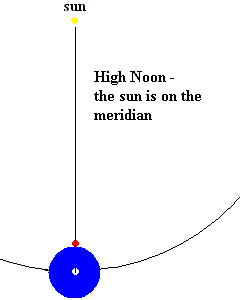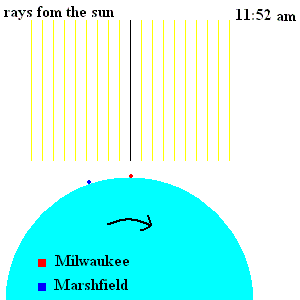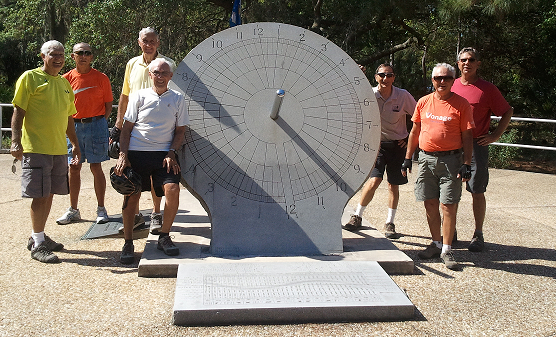
Ever since you were in kindergarten, your teachers drilled it in you that every day ... Earth spins once on its axis. I'm sure you were told this because your teacher actually didn't know any better. The fact is, our concept of a "day" is based on the apparent motion of the sun in the sky and is a bit more complicated than what your earlier instructors told you.
The Earth spins once on its axis every 23 hours, 56 minutes (rounded to the nearest minute). The time to complete one complete rotation is known as a sidereal day and is quite different from the traditional concept of a "day"
For astronomers, the day actually begins when the sun crosses the meridian. We can call this "high noon" ... an old cowboy phrase which means that the sun is at its highest point in the day. You will soon see that the clock rarely reads 12:00 at this time (stay tuned ... ). The rotation of Earth on its axis eventually forces the sun to set in the west, rise again in the east, and move back to the meridian (high noon). This defines a solar day - high noon to high noon. The first thing you have to realize is that Earth spins slightly more than one full rotation during a solar day. The animation below should convince you that a solar day is slightly longer than a sidereal day.

Sidereal and solar day (animation not to scale)
The red dot represents the observer. The observer's day starts when the sun crosses the meridian. But Earth is revolving around the sun at the same time it is rotating on its axis. One sidereal day later, Earth has made one complete rotation, but Earth needs to rotate just a little bit more (about 1 degree more) to align back to the sun and complete the solar day.
I made a short video that will try to convince you that the duration of a solar day varies throughout the year. Click here to watch that video.
The duration of a solar day varies throughout the year. That is, if you were to measure the time from high noon to the next high noon, you would get a different value every day. Why? Actually it's pretty complicated because one of the variables has to do with the tilt of earth's axes .... which we will not even try to explore. However, another variable is quite easy to see. Kepler's Second Law tells us that the speed of the earth's revolution around the sun varies ... moving fastest at perihelion and slowest at aphelion. The rotation rate of Earth, however, remains fixed (at least in the short term). Now consider the animation above and contemplate the results if Earth were revolving much faster around the sun. It would take slightly longer for Earth to align back with the sun ... making that particular solar day longer in duration.
|
At aphelion, a solar day goes fast. |
At perihelion, a solar day takes longer. |
Wow .. does this complicate things! Suppose you are a clock maker and you have to decide how fast (at what rate) your clock should run. You have basically two choices:
The logical answer is #2. So what rate do you choose? Any mathematician would know that you shoot for the average. As a result, clocks run at a rate known as the mean solar day. That is, the 24 hour day you are accustomed to is based on the average duration of all the individual solar days throughout the year.
Since our clocks run at a steady rate (mean solar day), but the individual solar days vary in duration, we are forced to allow the clocks and the sun to "drift apart" on occasion. That is, when our clocks read 12 noon, the sun is not necessarily on the meridian. Suppose you were to mark the position of the sun in the sky every day when your clock reads noon (or any designated fixed time for that matter ... ignoring daylight saving time). The pattern it would make throughout the year would look like a "figure 8" in the sky and is known as the analemma.
 |
|
The Analemma
Used with permission
Copyright © 2001-2004, Anthony Ayiomamitis. All rights reserved.
The huge drift in the north-south direction is a result of our 23˝ degree tilt as we revolve around the sun. You should be able to predict which images were taken on the summer and winter solstices. The smaller drift in the east-west direction is a result of the discrepancy between the clocks and the sun discussed above. There are other astronomical effects which make contributions to this east-west drift, but they will not be addressed here.
Please watch my .wmv format (5 MB) or .mp4 format (2MB) movie ... which shows the drift of the noon-time sun over the course of a full year.
Two additional images of the analemma at http://apod.gsfc.nasa.gov/apod/ap030320.html and http://apod.gsfc.nasa.gov/apod/ap020709.html
Having an expensive watch does no good if it isn't set to the correct time. All you have to do now is get it on the internet. But how was this accomplished before we had the internet, or even telephones?
Back in the 1880's, this was a real problem. The solution was not too scientific and usually quite informal, but it worked .... set up a sun dial, and when it read 12, it was noon. It should be clear from the discussion above that you automatically had errors built into the system. The analemma indicates that the sundial could be as much as 16 minutes off from the actual time, but if anyone cared they could compensate by referencing the equation of time. This "equation" is actually a chart which tells you the difference between clocks and sundials for any given day. The town timekeeper could make the necessary adjustments and ring huge church bells to let everyone know the correct time. They still chime out the time in many European cities. So why was this a big problem? Every town had its own "local standard". If a person were to get on a train and move from one town to the next, they would have to re-set their watch at each stop. This became a nightmare because long distance commutation and travel was now possible. The solution was another compromise which certainly made things convenient but allowed another "drift" between the clocks and the sun.
In 1883, the railroads initiated standard time in the US and Canada. The US was divided into 4 time zones: Pacific, Mountain, Central (which includes Wisconsin), and Eastern.
The 4 time zones established by standard time.
All residence within each zone would set their watches and clocks to the same time, regardless what the sundial said. There is a one hour difference between adjacent zones.
The difference between the clocks and the sun just got larger as a result of standard time. The "center" of the central time zone is 90 degrees west longitude. Marshfield, Wisconsin just happens to be located at this longitude, so let's consider the situation from that particular location first. Any resident of Marshfield, Wisconsin who owns a sundial (which is set up properly), needs only to read their sundial and reference the equation of time (see adjustment mentioned above) to determine the actual time. But what about other Wisconsinites who live in cities like Milwaukee? The longitude of Milwaukee is 88 degrees west. The Earth takes 4 minutes to rotate 1 degree. This means Milwaukeeans observe a sun which is 8 minutes offset from an observer in Marshfield, Wisconsin. Specifically, we observe the sun cross the meridian 8 minutes earlier than an observer in Marshfield. The farther you are from 90 degrees west longitude, the bigger the "drift" between the sun and the clocks.

The "Milwaukee sun" is ahead of the "Marshfield sun" (animation)
If things were not bad enough, the biggest adjustment between the sun and our clocks occurs when daylight saving time is in effect. First proposed by Benjamin Franklin, DST wasn't put into effect until World War I in an effort to save energy by moving the sunlight to the later part of the day when people were more likely to be working. DST was again temporarily initiated during WWII and eventually enacted into law on a permanent basis. A popular charcoal company even lobbied congress to extend DST an extra 3 weeks because their research showed that people are more likely to BBQ if it was still light out when they come home from work. Daylight Saving essentially throws the sun and the clocks out of sync by a full hour.
Congress keeps making changes to when DST is put into effect. In 1973, Congress even tried an experiment to keep DST in effect permanently throughout the year. That "experiment" was later reversed because kids were getting on school buses in the dark during the winter months. For now, from the second Sunday in March until the first Sunday in November, we move our clocks 1 hour ahead. The Sunshine Protection Act may change that by making DST permanent (again) but it only passed the Senate in 2022. It has yet to be voted in Congress and signed into law.

I made my biking buddies pedal 40+ miles to see this great sundial.
A sundial measures Local Apparent Time ... commonly called "sun time". When your sundial reads noon, your wall clocks will most likely read something else (for the reasons mentioned above). If you happen to own a sundial, you can still use it as long as you understand the required adjustments. First make sure it is level, the center "12 noon position" is facing true north, and the gnomon (pointer) is angled to your latitude (which is 43 degrees in Milwaukee).
After you read the sundial, you then need to make 3 adjustments to convert the time to a traditional clock.
If daylight saving time is in effect, add one hour
If you are in Milwaukee, subtract 8 minutes. Add or subtract 4 minutes for each degree of longitude you are from the center of your time zone. Subtract if you are east of the center line, add if you are west of it.
Look up the Equation of Time (or a super accurate page) for the given date and make the appropriate adjustment. For example, if it is July 4th, you need to add 4 minutes to your reading.
Example: On July 19th in Milwaukee, you look at your sundial and see that the local apparent time reads 2:30 pm. What will your clock read? Daylight saving is in effect, so move ahead one hour or 3:30 pm. But all Milwaukeeans are 2 degrees east of the center of the time zone (88 degrees vs. 90 degrees west) ... so subtract 8 minutes or 3:22 pm. Finally, a glance of the Equation of Time shows a correction of -6 minutes is needed. A negative number means the sun is behind the clocks (clocks are ahead of the sun) so you have to add 6 minutes to the sundial reading. The actual time on the clocks (standard time) should be 3:28 pm.
Better yet, just ditch the old sundial and buy yourself a $5 watch.
In the last unit you saw that a.m. and p.m. make reference to the meridian. An appointment at 11:40 a.m., means "ante meridian" which is Latin for "before" the sun crosses the meridian ... and p.m. means "post meridian" which indicates the sun has past the meridian. Military Time uses a 24 hour clock and does away with a.m. and p.m. So 3:00 p.m. is simply 1500 ... you may even have a watch which lets you change the display to 24 hr mode (Military Time).

Since there are 24 time zones throughout the world, it becomes impractical to convey an event by listing it 24 separate times. Astronomers (as well as world bankers, hospitals, airlines, etc.) have adopted a global time system known as universal time - or UT (sometimes known as UTC for Coordinated Universal Time or GMT - Greenwich Mean Time). Basically it is Greenwich Standard (Mean) Time at the Royal Observatory in Greenwich England expressed in Military Time. This link will tell you what UT is now. Central standard time is 6 hours behind UT and Central Daylight Time is 5 hours behind UT. If an astronomical event is said to occur at 19:34 UT on January 1, plan to witness it at 13:34 (or 1:34 p.m.) in Milwaukee.
Would you purchase a clock which runs 4 minutes too fast every day? Astronomers love clocks like this.
A sidereal day is one true rotation of Earth on its axis (with respect to the stars). Astronomers have measured this event at 23 hours 56 minutes (rounded). Astronomers have also developed a time system (and even clocks) which are based on this time period and call it sidereal time. Unless you are an astronomer, I can almost guarantee you that you have never seen a sidereal clock before. It is based on Military Time (24 hour mode), but goes through its cycle in one sidereal day. That is, it runs about 4 minutes faster per day than the clocks on your wall. Why would astronomers want such a clock? If you recall from the last unit, the sky is mapped in the east-west direction with a system called right ascension. The units were expressed in units of time ... but not the time units you are used to. The right ascension of astronomical objects are expressed in sidereal time units.
Any astronomer who has a sidereal clock (which is properly calibrated), or who knows the local sidereal time has a valuable piece of information. This time indicates what part of the celestial sphere is currently on the observer's meridian. That is, if the local sidereal time is 16:37, an astronomer would know that any celestial object with a right ascension of 16 hours, 37 minutes would be at the best viewing location ... on their meridian.
Who decided how long an hour should last? This is equivalent to asking why there are 24 hours in a day ... and not 30, 50 or 100. The answer came from early Egyptian astronomy. This early civilization had some unique perspectives of the sky. The Egyptians worshiped and revered the bright star, Sirius. This star is hidden in the glare of the sun during the early part of summer (which is why they thought it was so hot then). In late summer, around August, the suns movement along the ecliptic makes Sirius again visible in the early pre-dawn sky ... just above the eastern horizon. (Note: Sirius is also known as the "Dog Star" ... so these times became known as the "dog days of summer".) This first sighting of Sirius was considered an important and sacred event to the Egyptians. In order to anticipate the actual rising of Sirius, the astronomers noted 11 other stars ... all equally spaced across the night sky. Each would rise in the east approximately 1 hour apart ... defining the unit in the process. The 12th star in this procession was Sirius itself. To honor each star, sundials would record the passage of the sun using the same units ... hence, 12 hours per night ... and 12 hours per day.
©Jim Mihal 2004, 2014, 2021 - all rights reserved